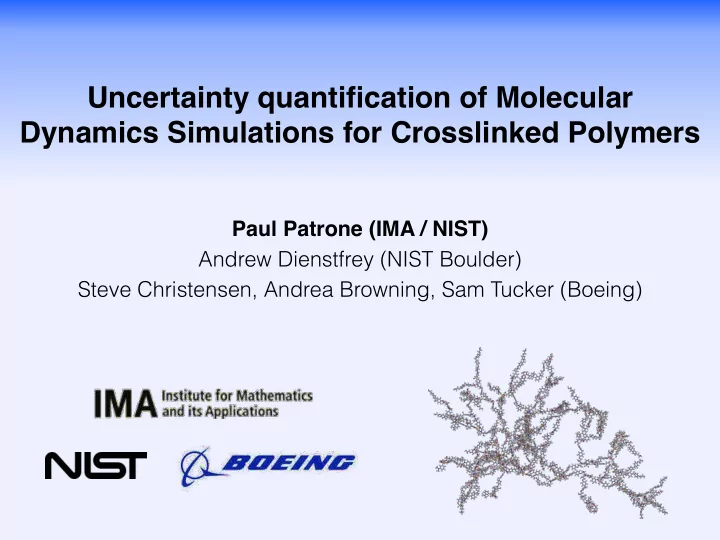

Uncertainty quantification of Molecular Dynamics Simulations for Crosslinked Polymers Paul Patrone (IMA / NIST) Andrew Dienstfrey (NIST Boulder) Steve Christensen, Andrea Browning, Sam Tucker (Boeing)
Backstory: Macro-economics of materials science Advent of composites dramatically altered design space in aerospace engineering. Example: Boeing 787 1 st aircraft with majority carbon-composite structural components Lighter aircraft —> fuel savings (20%) Scale of economics (~ 1000 orders) x (~ $250 Million / order) = $250 Billion
Impact of advanced materials Cumulative orders of 787 (blue) and deliveries (green) (Wikipedia) 2006 Seattle Times headline Airplane kingpin tells Airbus: Overhaul A350 “That’s probably an $8 billion to $10 billion decision.”
Impact of advanced materials Cumulative orders of 787 and A350 2006 Seattle Times headline Airplane kingpin tells Airbus: Overhaul A350 “That’s probably an $8 billion to $10 billion decision.”
Accelerating market insertion: materials by design Assume “Design space” of ingredients Finite simulation resources (Very) Few experiments Goal Find chemistry with, e.g. highest T g
Roles of UQ in modeling workflows Verification Validation Check math, Calibrate model remove bugs Estimate uncertainties Does data look arising from …. like I expect? Data of sufficient quality calibration parameters to make predictions? missing physics Compute uncertainties model form error arising from within model . Otherwise assume model Test “real-world” is valid at this stage predictive power
Roles of UQ in modeling workflows Verification Today’s focus on Check math, verification remove bugs Does data look Helps modelers to be like I expect? precise about what they mean Data of sufficient quality to make predictions? Improves reproducibility Compute uncertainties arising from within model . Streamlines validation Otherwise assume model is valid at this stage
Some complicating issues for Tg Incomplete list 1. Can we extract meaningful T g from simulated data 2. How to combine data? 3. How to work within non- analytic design space? Hardened & verified workflow to assess simulations
Assessing ability to extract T g Consistency with underlying definitions T g defined as hyperbola center (same as asymptote intersection) Automatically finds “asymptotic regimes” Data inconsistent with T g if asymptotic regimes far away
Assessing ability to extract T g Convergence to bulk limit An industry oxymoron: high-throughput, bulk-scale, atomistic-detail MD This is not bulk This is not bulk…? How do we know?
Observations from statistical mechanics N → ∞ As # of particles 1) measurable quantities are independent of N 2) variances of measurable scale as 1 /N Hyperbola fit (non-linear) ( ) T g = H T , ρ Analytically: density data temperatures ( ) ( ) + δρ N ( ) ⋅∇ ρ H 2 As N → ∞ , T g ≈ H T , ρ ) + O δρ ( T , ρ bulk mean 1/ N fluctuations Hyperbola fit approximately linear
Observations from statistical mechanics ( ) ( ) + δρ N ( ) ⋅∇ ρ H 2 As N → ∞ , T g ≈ H T , ρ ) + O δρ ( T , ρ Large fluctuations => non-linear correction bias Two ways this approximation can fail Average density not converged Large fluctuations => non-linear correction bias
Assessing ability to extract T g Is hyperbola fit biasing results? Test for bias (pooling) ⎛ ⎞ M Construct average T g,i from ⎜ ⎟ ⎝ ⎠ m every combination of m data sets chosen from a total of M − 1 ⎛ ⎞ T = M ∑ ! = constant T g , i ⎜ ⎟ } ⎝ ⎠ m i IF linearity holds ( ) σ 2 = 1 ∝ 1 ∑ 2 T g , i − ! T M − m m i
Assessing ability to extract T g Is average density converged?
Assessing ability to extract T g Is average density converged?
Assessing ability to extract T g Did we extract a “precise” T g value from the fit? ς i Noise affects fit, & (within-uncertainty) hence our T g estimate Noise model for residuals ρ ( T ) = ρ ( T ) + η η Sample noise & fit hyperbola to yield new T g
Combining data Should all data sets be treated equally? Two simulations may yield different within-uncertainties Worse, predictions may not overlap How do we account for missing physics?
Combining data Should all data sets be treated equally? Weighted-mean statistic model: T g from i th simulation − 1 ⎡ ⎤ T g , i ⎢ ⎥ 1 ∑ τ = y 2 + ς i y 2 + ς i ∑ ⎢ ⎥ 2 2 ⎢ ⎥ i ⎣ ⎦ i uncertainty from de-weights “imprecise” under-modeled physics & overconfident T i Solve for y using maximum likelihood analysis (MLE)
Combining data − 2 ( ) ⎡ ⎤ 2 T g , i − τ δ 2 = ⎢ ⎥ 1 ∑ Final uncertainty estimate: y 2 + ς i ∑ ( ) y 2 + ς i ⎢ ⎥ 2 2 2 ⎢ ⎥ i ⎣ ⎦ i
Open problems: yield strain Strain at which material no longer resists a load Identified as maximum of stress-strain curve How do we deal with noisy data? Analysis using convex functions.
Open problems: understanding statistics of “realistic” crosslinked networks What is mean number of edges at a given vertex? Depends on x-link algorithm: e.g. random bonding, nearest neighbor…. Analytical (probabilistic) models to describe simulated predictions
Conclusions MD is driving development of materials & other disruptive technologies UQ can help industry assess usefulness of their simulations Lots of open problems
Recommend
More recommend